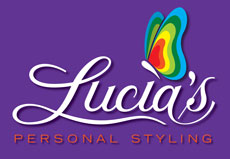How To Create A Capsule Wardrobe
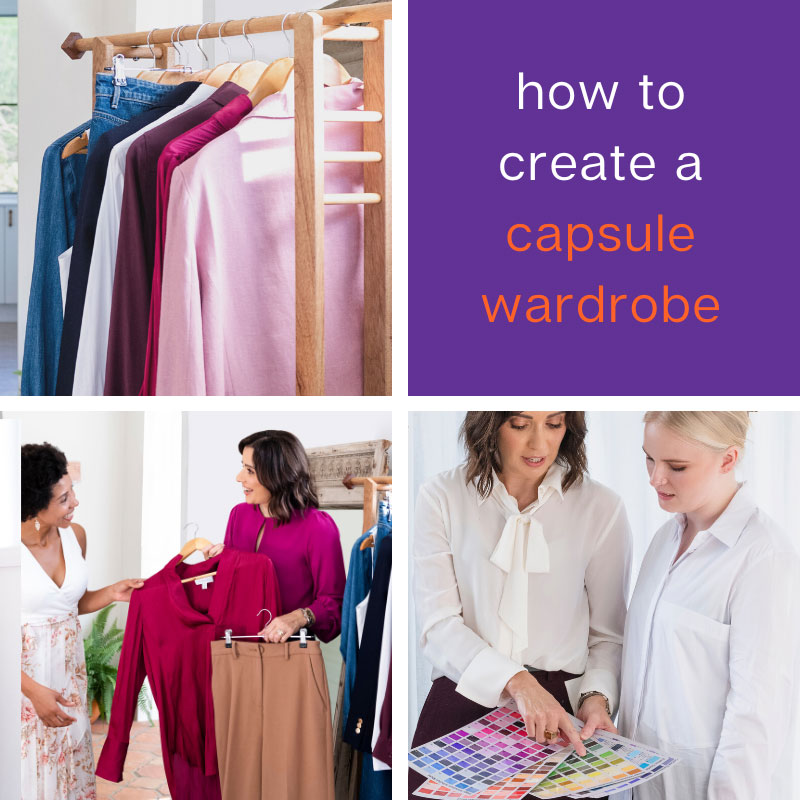
The rising cost of living is reason enough to start thinking more carefully about your clothing and accessory purchases if you haven’t already. Quality clothing and accessories are expensive so it makes sense to become a more discerning and conscious consumer, thoughtfully considering each garment purchase. We all know the mass production of clothing, ‘fast fashion’ and the trend driven push to ‘buy now’ and ‘buy new’ only adds to the overwhelming experience of shopping and dressing daily, often leaving many of us with regrettable clothing items hanging in our wardrobes, never to be worn. So, what can be done to make your wardrobe more functional, sustainable and joyful?
You can create a capsule wardrobe.
More of my clients, in recent times, are looking to cultivate a more minimal and streamlined approach to their wardrobes – one that offers them greater versatility, ‘mix and match’ style, maximising their clothing and outfit creation.
The environment in which you live has a substantial impact on this approach. For example, those who live in more milder climates can get away with a simpler, trans-seasonal closet; this is where the benefit of creating a capsule wardrobe really comes into its own. In other words, less extremes in temperature requires less variation in garment types.
What is a capsule wardrobe?
It is a wardrobe consisting of thoughtfully selected garments that can easily interchange with each other. These garments can form small collections or ‘clusters’ that offer multiple outfit creations.
What are the benefits of doing this?
- streamline your wardrobe
- maximise a garment’s versatility
- save you time creating and co-ordinating outfits that suit you and your lifestyle
- save you money as the cost per wear of garments will go down
- create a more sustainable wardrobe
- reduces stress and decision-making when it comes to ‘what to wear?’
- create greater opportunities for dressing daily with joy
Who does this suit?
Clients who prefer a more minimalistic approach to their wardrobe can range from busy professionals to busy stay-at-home mums and retirees. Generally, their personality style tends to be classic and natural. Those clients who are mood dressers, maximalists, or creative dramatics may struggle with this type of wardrobe so it may not be for everyone; it is a very personal and individual choice.
Before you start?
The best way to begin is to undertake a thorough wardrobe audit. Consider your personality, lifestyle, occupation, environment, colour direction (best basic, accent colours and neutrals), body shape and proportions, fabrics, prints, and your personal values. Let go of items that no longer serve you due to poor fit, inability to be altered, are outdated, stained, worn to a thread etc. Keep all the clothing items that are your favourites, that you enjoy wearing, are functional, and work well for you. While you are completing this process, create a shopping ‘wish list’ of items that YOU think are missing from your wardrobe. Your personal stylist will be able to offer further advice during a wardrobe consultation. These ‘missing items’ will be essential to creating your ‘clothing clusters’.
How to create a versatile small collection of garments or ‘clothing cluster’?
Six to eight interchangeable garments is a good place to start. You can base this first cluster on the appropriate season and work/life situation. For example, obviously business attire is worn for work purposes, casual and smart-casual wear is worn for everyday activities, and formal wear is required for weddings and other special events.
Each of these clothing types can be broken down into specific styles and fabrics you prefer to wear. For example, casual wear for a busy mum might include: cotton midi skirt, denim jeans, relaxed cotton tees, shorts, denim skirt, linen jumpsuit/day dress, denim jacket etc.
Next, select your six items of clothing that will form the basis of your cluster:
- Select an outer layer garment e.g. blazer
- Select two ‘bottom-half’ garments e.g. jeans, skirt
- Select three ‘top-half’ garments e.g. two t-shirts, knit top
Of course the fit and style of the garments need to suit your body shape, proportions and particular body features. The hand of the fabric and personal preferences (do you have an aversion to polyester or wool?) will also need to be adhered to. However, the key ingredient for these pieces to work together effortlessly will be their colour relationship. This is where knowing your ideal colour palette is essential. For example, if you know the undertone of your best colours (especially the neutrals) you will find that your ability to mix and match your tops with your pants/skirts/shorts is so much easier.
In addition to this, further thought must go into the colours and prints/patterns of these above items. You can imagine that if you aren’t a ‘pattern clasher’, you may not cope with 6 different patterned pieces. If you love colour, you probably won’t be happy if everything is in black and white. And if you have a warm undertone, black and white won’t be your best neutrals either, so you will need to know this first, in order to maximise the versatility of your garments and the ease in which you mix and match them. A personal colour analysis is one of the best investments you can make to develop your image and style confidence.
Your initial 6 items may look like this:
- Mid-blue classic fitted linen/viscose blazer
- Dark ink blue denim straight leg, high waisted stretch jeans, navy satin midi skirt
- White crew neck logo cotton t-shirt, navy and white striped crew neck cotton t-shirt, azalea pink short sleeved polyester/viscose blend knit top
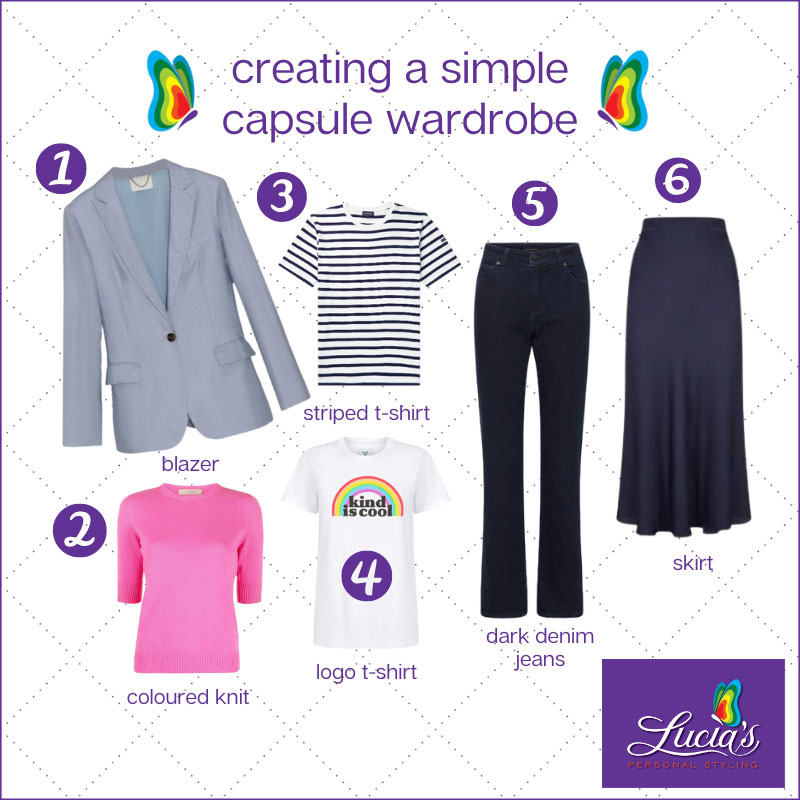
1.Wolf and Badger Blazer, 2. Gerry Weber pink knit 3. Mr Porter striped t-shirt, 4.Kind is Cool Australia logo t-shirt, 5. David Lawrence dark denim jeans, 6. There was One satin navy skirt
From these 6 items, you should be able to create 12 different outfits.
You can make lots of clothing clusters like this, extending your options further by including additional items as the seasons change, or if you need to update and/or replace essential favourites.
For example, you could add the following items to your initial cluster like this:
- Add a denim jacket, or long line cardigan, or trench, or leather jacket etc.
- Add tailored shorts, or cargo pants, or stretch bootleg ponte pants, or white jeans etc.
- Add a camisole top, or tank top, or ¾ sleeve top, or long sleeve silk shirt etc.
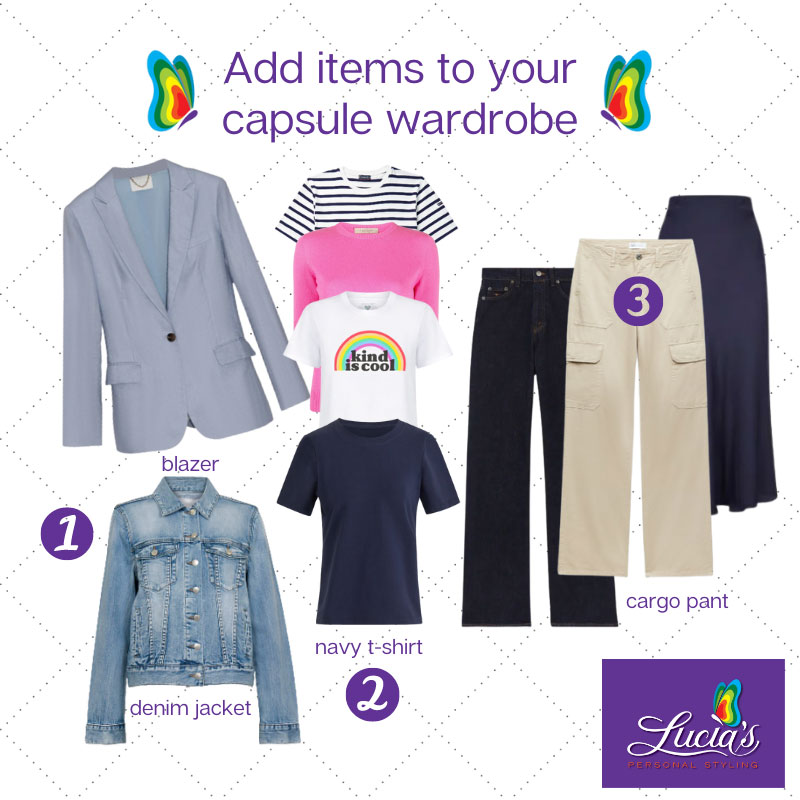
Build your capsule wardrobe and extend your options with additional items as the seasons change, if you need to update and/or replace essential favourites. For example, you could add: 1. denim jacket, 2. navy t-shirt, 3. lighter coloured relaxed pair of cargo pants.
You may prefer to maintain mostly a neutral palette or inject some block colours and prints (polka dot, check, stripes, animal print) as you go. Extend your cluster further by adding a couple of dresses in the mix, or swapping out one of your ‘bottom half’ items for a denim skirt. Again, it comes down to your personal preferences, what and how you like to wear your clothing.
Don’t forget your accessories!
Accessories are the icing on the cake when it comes to completing an outfit and adding polish and personality. Be mindful of the colours you select in relation to your shoes, bags, scarves and jewellery. Once again refer back to your colouring, personality and lifestyle needs.
Some examples of classic options could include:
- neutral coloured handbag/crossbody bag (taupe, sand, cream, grey, tan, navy and black are all great options depending upon your specific colour ID)
- neutral sneakers, sandals, loafers, wedges, court shoes etc.
- pearls, gold/silver hoop earrings, diamond pendant etc.
- neutral coloured black/tan/taupe belts
- scarf, lipstick in your signature colour!
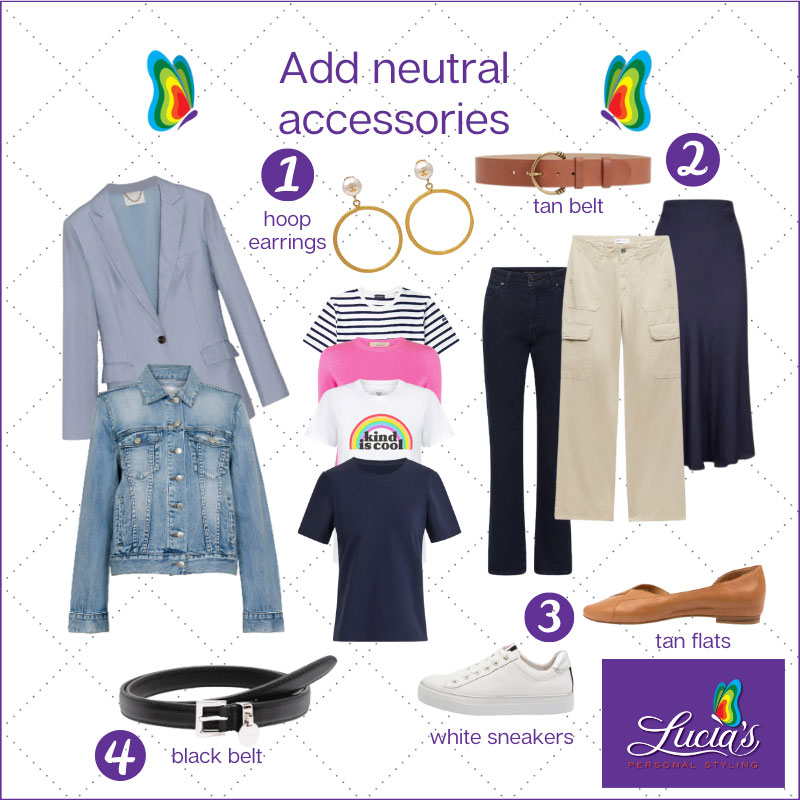
Accessories are the icing on the cake when it comes to completing an outfit and adding polish and personality. A good starting point is to stick to neutral colours according to your colour direction; this way they will mix and match effortlessly. I’ve opted for dark and lighter coloured belts, white sneakers (comfort is key for me because I walk a lot!) and a pair of pointy toe flats which team equally well with skirts/dresses and pants. They are also a little dressier which elevates the casual clothing to smart-casual. 1. Chanel gold and pearl earrings, 2. Witchery tan belt, 3. Midas tan flats and white sneakers, 4. Prada black belt
My final tip is if you wish to keep a record of the outfits you wore with success, take a selfie and store it on your phone for future reference.
A sustainable wardrobe that you love takes time. It goes without saying that how you hang, store and wash your garments is part of the equation when it comes to ensuring your garments last the distance.
If you lack the confidence or knowledge in choosing colours, educate yourself and invest in a personal colour analysis. Furthermore, if you unsure about the styles and fabrics of clothing that suit you best, engage the services of a qualified, professional personal stylist or image consultant to support and guide you along the way.
